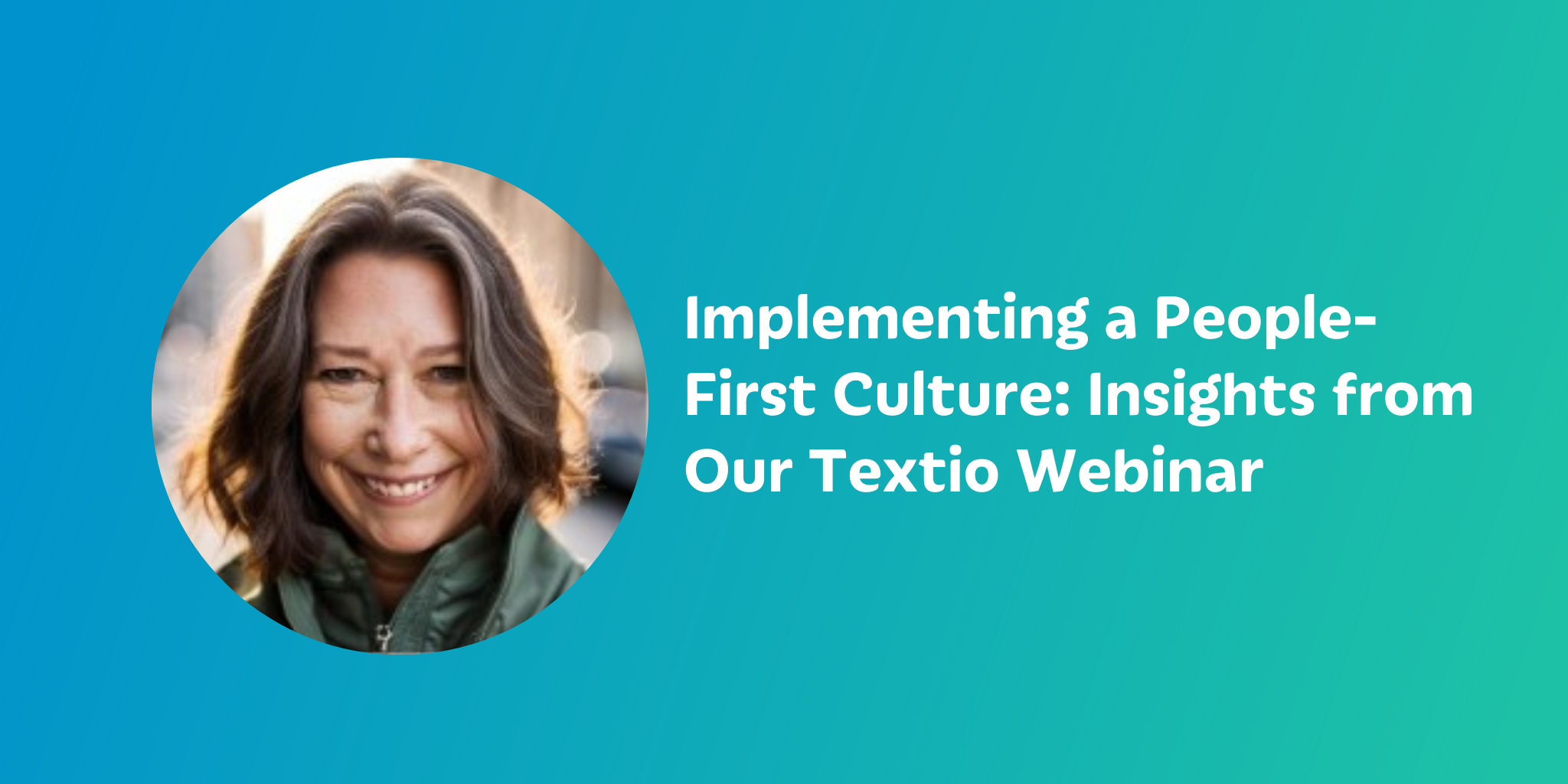Implementing a people-first culture: insights from our textio webinar
Discover actionable insights from Tracie Sponenberg’s latest blog post, "Implementing a People-First Culture," inspired by a thought-provoking Textio webinar. Learn strategies to foster trust, transparency, and growth in the workplace.
January 25, 2025

I'm thrilled to have partnered with Textio for another webinar, this time focusing on "Implementing a People-First Culture."
I joined Anessa Fike, CEO and founder of Fike & Company for the panel, which was moderated by Rocki Howard, founder of Diversiology I.O. and senior HR advisor at Textio.
The Urgency of People-First Cultures
Rocki kicked off the event by addressing the current challenging climate for inclusion and belonging. She highlighted recent events such as the rollback of transgender identity protections, the end of birthright citizenship, and the dismantling of DEI initiatives. In light of these challenges, Rocki emphasized the critical importance of discussing what it truly means to be people-first.
She stressed that a people-first culture isn't only about good intentions. A people-first culture is really about creating tangible systems that empower employees and drive business success. These two aspects are not mutually exclusive.
What Does a People-First Culture Really Mean?
A people-first culture is about prioritizing employees' well-being, growth, and engagement while aligning these priorities with business objectives. More specifically, as we spoke about in the webinar, it is all of these things and more”
-
Creating tangible systems that empower employees and drive business success.
-
Putting your people above everything, including profits.
-
Centering employees in decision-making and ensuring they understand how they impact the business.
-
A people-first culture requires trust as its foundation.
-
It involves transparent communication about the company's values and stance on important issues.
-
It includes implementing regular, constructive feedback mechanisms that are decoupled from compensation.
-
It requires developing self-aware leaders who understand their team members deeply.
-
It means creating dual career ladders to ensure growth opportunities for both managers and individual contributors.
-
It involves listening to employees and acting on their feedback.
-
It requires balancing business priorities with employee needs and well-being.
-
It means having difficult conversations when necessary, including terminations when appropriate, but always with dignity and respect.
Key Takeaways for Building a People-First Culture
Creating a people-first culture is not easy. Nor should it be. But, it is so worth it. Throughout our conversation, five key themes emerged:
-
Align People and Business Imperatives: We debunked the myth that people-first cultures are antithetical to business growth. In fact, they should be intrinsically linked for optimal success.
-
Embrace Transparency: Being clear about your company's values and stance on important issues helps attract aligned talent and builds trust.
-
Prioritize Feedback: Implement regular, constructive feedback mechanisms that are decoupled from compensation to foster growth and development.
-
Develop Self-Aware Leaders: Start with leadership self-awareness and extend that to understanding team members deeply.
-
Create Dual Career Ladders: Ensure growth opportunities for both managers and individual contributors to avoid promoting people into ill-fitting roles.
The Power of Listening and Feedback
A significant portion of our discussion centered on the critical role of listening and feedback in building a people-first culture. We emphasized that feedback should be a gift—timely, direct, and clear. It's about communication, not evaluation.
I experienced this firsthand mid-way through my career. I wasn’t a great leader – though I didn’t know that until someone on my team had the courage to have a very difficult conversation with me about how I led and offered feedback. It was so impactful, it changed how I led and how I viewed myself as a leader, co-worker and human. Though painful to hear at the time, it was, for me, the ultimate gift.
Overcoming Barriers to People-First Cultures
Creating a people-first culture does not happen overnight. In fact, it can take several years or more to bring about culture change. But that’s all the more reason to start to make change and eliminate barriers now. We talked about these three major barriers to creating people-first cultures, and how to overcome them:
-
Frontline Managers: Ensure they are properly trained and supported to handle employee concerns effectively.
-
CEO Buy-In: The CEO's commitment is crucial. I think every CEO should have a coach, mentor, or therapist – and ideally all three – to truly lead people-first
-
HR Self-Reflection: As HR professionals, we must continually evaluate our own practices and ensure we’re walking the talk.
Practical Strategies for Implementation
So, you’ve committed to embracing a people-first culture and started to think about removing barriers. What next?
We offered several great practical strategies that you can use to take the first step today:
-
Conduct stay interviews and listening tours to gather valuable insights from your team.
-
Re-evaluate past decisions, policies, processes and practices to ensure they are truly aligned with a people-first approach.
-
Utilize tools like Textio to improve communication and reduce bias in feedback and hiring processes.
-
Implement dual career ladders to provide growth opportunities for both managers and individual contributors.
Looking Ahead
As we continue to navigate the evolving workplace landscape, it's clear that implementing a people-first culture is essential. By focusing on our people, we create more engaging and productive work environments AND drive better business outcomes.
Creating and developing culture is ongoing, requiring consistent effort and intentionality. Your company culture is a living, breathing thing. Let's continue to champion the humans in our workplaces, fostering environments where everyone can thrive. After all, when we put our people first, everything else follows.
📹Missed the webinar? Listen to the replay here
- Tracie Sponenberg